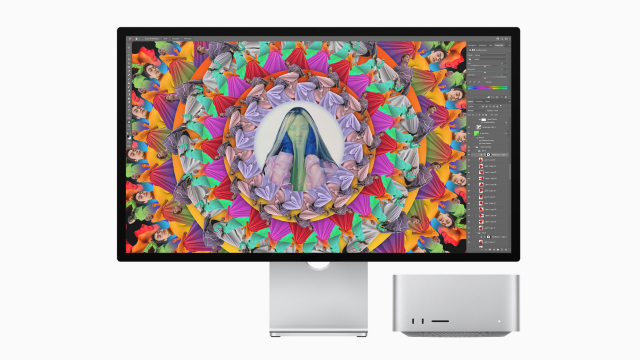While Apple on Wednesday put rumours to bed around its budget-friendly iPhone SE 5G, gave us two green iPhone 13s and dropped a pretty compelling 5th gen iPad Air, the star of its Peek Performance show was without a doubt the all-new Mac Studio and Studio Display.
Apple just filled a gaping hole in its product lineup with the Mac Studio, so let’s start there.
Mac Studio
The Mac Studio packs Apple’s M1 Max chip or its newly-announced M1 Ultra. The M1 Ultra is without a doubt Apple’s most powerful chip yet. Apple reckons it delivers “unprecedented performance and extensive connectivity in an incredibly compact design”.
Before I go any further, I need to tell you how much you can expect to splash on this thing – Mac Studio starts at $3,099 RRP. (Is that $99 truly necessary, Apple?). It’s expensive but in Apple dollars, it’s more affordable.
Apple says the Mac Studio is built from a single aluminium extrusion and that given it features an “innovative thermal design”, it can provide an extraordinary amount of performance.
“The unique system of double-sided blowers, precisely placed airflow channels, and over 4,000 perforations on the back and bottom of the enclosure guide air through the internal components and help cool the high-performance chips,” it says, adding this little thing is ultra quiet.

Mac Studio specs
Measuring 19.7 cms x 9.5 cms, this thing is small.
But don’t let its size fool you, it boasts groundbreaking performance.
Powered by either the M1 Max or M1 Ultra (not both, obviously). If packed with the former, Apple says you can expect up to 2.5x faster CPU performance than the fastest 27-inch iMac with 10-core processor, up to 50 per cent faster CPU performance than Mac Pro with a 16-core Xeon processor, up to 3.4x faster graphics performance than the 27-inch iMac, and over 3x faster than Mac Pro with its most popular graphics card and up to 7.5x faster than the 27-inch iMac, and up to 3.7x faster than 16-core Mac Pro when transcoding video.
The M1 Ultra, however, boasts up to 3.8x faster CPU performance than the fastest 27-inch iMac with 10-core processor, up to 90 per cent faster CPU performance than Mac Pro with 16-core Xeon processor, up to 60 per cent faster CPU performance than 28-core Mac Pro, up to 4.5x faster graphics performance than the 27-inch iMac, and up to 80 per cent faster than the fastest Mac graphics card available today and up to 12x faster than the 27-inch iMac, and up to 5.6x faster than 28-core Mac Pro when transcoding video.
Mac Studio with M1 Ultra can play back 18 streams of 8K ProRes 422 video. Apple claims no other computer in the world can do this. It also claims Mac Studio shatters the limits of graphics memory on a desktop, featuring up to 64GB of unified memory on systems with M1 Max and up to 128GB of unified memory on systems with M1 Ultra.
On the back, Mac Studio includes four Thunderbolt 4 ports to connect displays and high-performance devices, a 10Gb Ethernet port, two USB-A ports, an HDMI port and a pro audio jack. On the front, there’s also some more ports – two USB-C ports, which on M1 Max supports 10 Gbps USB 3, and on M1 Ultra supports 40 Gbps Thunderbolt 4. There is also an SD card slot on the front.
Wi-Fi 6 and Bluetooth 5.0 are built in, too.
Studio Display
Studio Display sees Apple re-enter the mainstream monitor space. Studio Display features a 27-inch 5K Retina screen, an advanced camera with Centre Stage aaand Apple reckons it boasts amazing high-fidelity audio. It’s clearly marketed towards creatives.
Up until today, the only monitor Apple sold was the Pro Studio XDR, which is a 32-inch, 6K display that costs $9,999 if you get the nano-texture glass and add the stand for another $1,699. Studio Display will set you back $2,499 RRP. And while not a budget monitor, it makes sense than the bigger monitor if you just want it as a companion to your MacBook Pro (or the new Mac Studio desktop). But if you do what Apple says you can do (connect up to three displays to your MacBook), you’re looking at a very intimidating $7,497.

Studio Display specs
The 27-inch 5K Retina screen boasts over 14.7 million pixels and 600 nits of brightness, P3 wide colour and support for over 1 billion colours. True Tone technology also automatically adjusts the display’s colour temperature as the environment changes and they boast an antireflective coating. Studio Display offers a nano-texture glass option, which was first introduced with the Pro Display XDR. It is of course powered by macOS Monterey.
The Studio Display features a 12MP Ultra-Wide camera with Centre Stage (a feature that automatically keeps users centred in the frame as they move around for even more engaging video call), thanks to the A13 Bionic chip. It also packs a three-microphone array.
Studio Display has three USB-C ports that deliver speeds up to 10 Gbps, the same port also delivers 96W of power to a Mac notebook.
Magic Keyboard and Magic Mouse
There’s also a new silver-and-black colour option for the Magic Keyboard with Touch ID, Magic Trackpad and Magic Mouse. Magic Keyboard with Touch ID and Numeric Keypad will set you back RRP $279, Magic Trackpad $209 and Magic Mouse $139.
The Mac Studio and Studio Display will be available from March 18. This article has been updated since it was first published.
